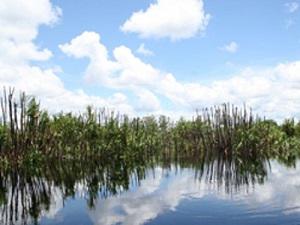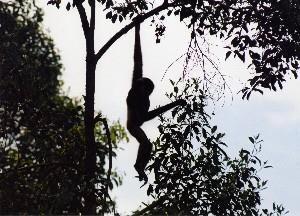Claire Thompson
This project will study how gibbons adapt to forests where there are uneven canopy layers and gaps, thus improving our understanding of how adaptable they are to disturbance and the level of disturbance it takes to render a habitat unsuitable for supporting a sustainable gibbon population.

River Sebangau.
I will use a PCI (Perceived Continuity Index) model to assess locomotory techniques used by gibbons to cross canopy gaps in areas with varying levels of disturbance. This will improve knowledge of how gibbons adapt to forests where there are uneven canopy layers and gaps, thus improving our understanding of how adaptable they are to disturbance and the level of disturbance it takes to render a habitat unsuitable for supporting a sustainable gibbon population.

Agile gibbon feeding.
The Sebangau National Park, where this study will take place, has been estimated (through on-going density surveys using song triangulation) to hold about 30,000 individuals. This is believed to be one of the largest remaining populations of Bornean agile gibbons. The PCI data, combined with long-term habitat data collected since June 2003, will provide essential information on how gibbon locomotion is affected by habitat disturbance and what levels of disturbance they can tolerate before their behaviour is permanently changed, i.e. they start coming to the ground to cross gaps or need to take less direct travel routes. Decreased travel efficiency will make energy balances more negative, possibly affecting reproduction and the population’s long-term viability. The national park will benefit from the work, as it will highlight the importance of good-quality habitat for gibbon survival. The information will lead to further understanding of how adaptable gibbons are to different levels of forest disturbance. The results will also improve the scientific status of the national park, and will be crucial in helping developing effective management plans for the protection of the forest and the reduction of gaps.
On completion of this study, results will be disseminated to all interested parties, in particular the Centre for the International Cooperation in Management of Tropical Peatland’s (CIMTROP) education team, who work closely with the local community, involving them in fire-fighting training and management, education in local schools and local communities on conservation-based issues. This study will contribute to a larger on-going Post-Doctoral and PhD study (Dr S. M. Cheyne and Mr M. E. Harrison) on the behaviour and feeding ecology of gibbons and orang-utans in peat swamp forest and the affects of anthropogenic disturbances on these apes. They then will be disseminated to an even wider audience by publication of results in scientific journals and popular articles.